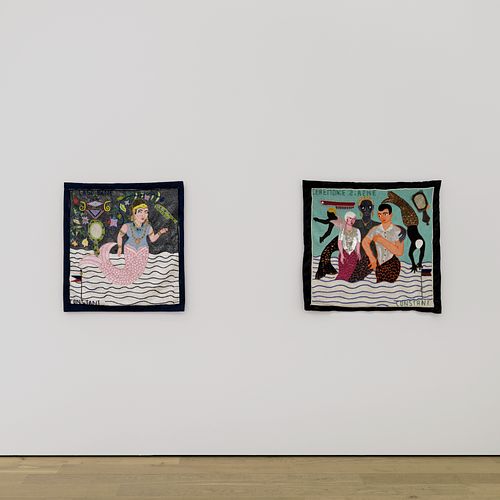AUDIO
Myrlande Constant
A sparkling tapestry. Gold, silver, turquoise. Sequins, beads, embroidery. And in the middle of it all: a mermaid with a mirror and a comb. What looks at first glance like a fairy-tale character is actually a goddess: Lasirène—Queen of the Oceans in Haitian Vodou. Myrlande Constant has rendered Lasirène in fabric. To achieve this, she used the French technique of tambour embroidery, in which artists embroider the fabric from the reverse side using beads and sequins.
Born in Port-au-Prince, Constant creates drapo, traditional liturgical flags used in Vodou ceremonies. However, the artist has appropriated this craft, reinterpreted it, expanded it, and turned it into something new. For example, she introduced the use of glass beads in the flags to create her pictorial tableaux. The tableaux express a deep spiritual connection and reflect Haiti’s colonial heritage. Her works tell stories and take a political stance. In addition, she has taken over a craft that for many years only men could practice, and has made it accessible to all genders by setting up her own studio.
In Ceremonie Sirene, a Black mermaid rises up out of the ocean. She has braided blonde hair, golden jewelry, a piercing gaze. Water creatures, waves, and ornaments surround her—perhaps representing the anba dlo, the underwater realm where the souls of people enslaved by colonial rulers live on, those who died on slave ships on the way to the Americas, who were thrown overboard and left to their fate.
The same goddess looks completely different in the second work, Lasirène. Here, she appears fair-skinned, almost European, in front of the Haitian flag. She wears jewelry, and carries a mirror and a comb. The mirror symbolizes the gateway to the spirit world, while the comb represents beauty and femininity. This also forms part of the story, because Vodou arose out of an interweaving of African, European, and Caribbean influences. It also serves as a system of resistance that lives on in images, songs, and rituals.
Constant’s tapestries are therefore much more than mere decoration. They form part of a cultural memory, a repository for pain, for hope, for survival. They show how spirituality becomes language—and fabric becomes a witness.
Stay where you are for a moment. Let the images sink in. Perhaps you’ll hear something. Maybe Lasirène will whisper in your ear.
Born in Port-au-Prince, Constant creates drapo, traditional liturgical flags used in Vodou ceremonies. However, the artist has appropriated this craft, reinterpreted it, expanded it, and turned it into something new. For example, she introduced the use of glass beads in the flags to create her pictorial tableaux. The tableaux express a deep spiritual connection and reflect Haiti’s colonial heritage. Her works tell stories and take a political stance. In addition, she has taken over a craft that for many years only men could practice, and has made it accessible to all genders by setting up her own studio.
In Ceremonie Sirene, a Black mermaid rises up out of the ocean. She has braided blonde hair, golden jewelry, a piercing gaze. Water creatures, waves, and ornaments surround her—perhaps representing the anba dlo, the underwater realm where the souls of people enslaved by colonial rulers live on, those who died on slave ships on the way to the Americas, who were thrown overboard and left to their fate.
The same goddess looks completely different in the second work, Lasirène. Here, she appears fair-skinned, almost European, in front of the Haitian flag. She wears jewelry, and carries a mirror and a comb. The mirror symbolizes the gateway to the spirit world, while the comb represents beauty and femininity. This also forms part of the story, because Vodou arose out of an interweaving of African, European, and Caribbean influences. It also serves as a system of resistance that lives on in images, songs, and rituals.
Constant’s tapestries are therefore much more than mere decoration. They form part of a cultural memory, a repository for pain, for hope, for survival. They show how spirituality becomes language—and fabric becomes a witness.
Stay where you are for a moment. Let the images sink in. Perhaps you’ll hear something. Maybe Lasirène will whisper in your ear.
